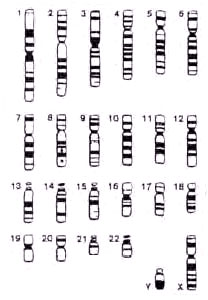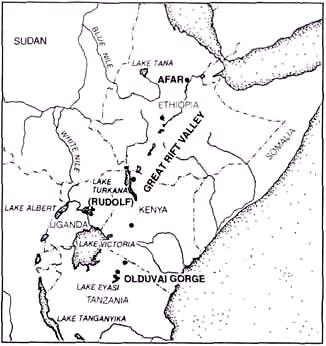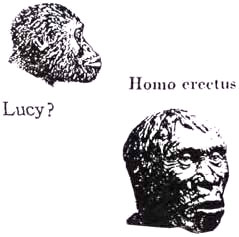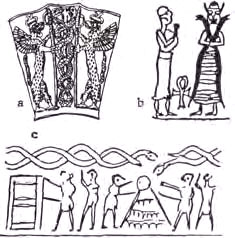|
9 - THE MOTHER CALLED EVE
The Akkadian term, as earlier stated, was a rendering of the Sumerian SHI.IM.TI, a compound word in which each of the three components conveyed a meaning that combined with, strengthened, and expanded the other two. SHI stood for what the Bible called Nephesh, commonly translated “soul” but more accurately meaning “breath of life.”
IM had several meanings, depending on the context. It meant “wind,” but it could also mean “side.” In astronomical texts it denoted a satellite that is “by the side” of its planet; in geometry it meant the side of a square or triangle; and in anatomy it meant “rib.” To this day the parallel Hebrew word Sela means both the side of a geometric shape and a person’s rib. And, lo and behold, IM also had a totally unrelated fourth meaning: “clay.”... As if the multiple meanings “wind”/”side”/”rib”/”clay” of IM were not enough, the term TI added to the Sumerians’ linguistic fun.
It meant, as previously mentioned, both “life” and “rib”—the latter being the parallel of the Akkadian situ, from which came the Hebrew Sela. Doubled, TI.TI meant “belly”—that which held the fetus; and, lo and behold, in Akkadian titu acquired the meaning “clay,” from which the Hebrew word Tit has survived. Thus, the component TI of the laboratory’s Sumerian name, SHI.IM.TI, we have the meanings “life”/”clay",”belly",”rib.”
Therefore is the being called Ish-sha [”Woman”] because out of Ish [”Man”] was this one taken. Therefore doth a man leave his father and his mother and shall cleave unto his wife to become as one flesh.
An incision is made and a rib is removed. The flesh is then pulled together to close up the wound, and Adam is allowed to rest and recover. The action continues elsewhere. The Elohim now use the piece of bone to construct a woman; not to create a woman, but to “construct” one. The difference in terminology is significant; it indicates that the female in question already existed but required some constructive manipulation to become a mate for Adam. Whatever was needed was obtained from the rib, and the clue to what the rib supplied lies in the other meanings of IM and TI—life, belly, clay. Was an extract of Adam’s bone marrow implanted in that of a female Primitive Worker’s “clay” through her belly?
Regrettably, the Bible does not describe what was done to the female (named Eve by Adam), and the Sumerian texts that have surely dealt with this point have not been found so far. That something of the kind did exist is certain from the fact that the best available translation of the Atra Hasis text into Early Assyrian (about 850 B.C.) contains lines that parallel some of the biblical verses about a man leaving his father’s house and becoming as one with his wife as they lie in bed together. The tablet that carries this text is too damaged, however, to reveal all that the Sumerian original text had to say.
Figure 59
Adam and Eve discovered their sexuality, having acquired “knowing”—a biblical term that connoted sex for the purpose of procreation (“And Adam knew Eve his wife and she conceived and gave birth to Cain.”). Eve, as the tale of the two of them in the Garden of Eden relates, was thenceforth able to become pregnant by Adam, receiving from the deity a blessing combined with a curse:
Homo sapiens was able to procreate and multiply on his own. But though he was given a good measure of the genetic makeup of the Anunnaki, who made Man in their image and after their likeness even in this respect of procreation, one genetic trait was not transmitted. That was the longevity of the Anunnaki. Of the fruit of the “Tree of Life,” partaking of which would have made Man live as long as the Anunnaki, he was not even to taste. This point is clearly spelled out in the Sumerian tale of Adapa, the Perfect Man created by Enki:
Ever since publication of The 12th Planet in 1976, I have spared no effort to explain the seeming “immortality” of the “gods.” Using flies in my home as an example, I have been wont to say that if flies could talk, Papa Fly would tell Son Fly,
My “immortality” (in the eyes of the talking flies) is, of course, simply a result of the different life cycles. Man lives so many decades of years; flies count their lives in days. But what are all these terms? A “day” is the time it takes our planet to complete one revolution about its axis; a “year” is the time it takes our planet to complete one orbit around the Sun. The length of time activities by the Anunnaki took on Earth was counted in sars, each one equivalent to 3,600 Earth-years. A sar, I have suggested, was the “year” on Nibiru—the time it took that planet to complete one orbit around the Sun.
So when the Sumerian King Lists reported, for example, that one leader of the Anunnaki administered one of their cities for 36,000 years, the text actual states ten sars. if a single generation for Man is twenty years, there would be 180 generations of Man’s progeny in one Anunnaki “year”—making them appear to be Forever Living, “immortal.” The ancient texts make clear that this longevity was not passed on to Man, but intelligence was. This implies a belief or knowledge, in antiquity, that the two traits, intelligence and longevity, could somehow be bestowed upon or denied to Man by those who had genetically created him.
Not surprisingly, perhaps, modem science agrees.
Besides giving examples of geniuses in various fields who had bequeathed their talents to children and grandchildren, the article highlighted a report by researchers from the University of Colorado at Boulder and Pennsylvania State University (David W. Fulker, John C. DeFries, and Robert Plomin), who had established a “close biological correlation” in mental abilities attributable to genetic heredity. Scientific American headlined the article, “More Evidence Links Genes and Intelligence.”
Other studies, recognizing that “memories are made of molecules,” have led to the suggestion that if computers are ever to match human intelligence, they ought to be “molecular computers.” Updating suggestions made in this direction by Forrest Carter of the Naval Research Laboratories in Washington, D.C., John Hopfield of Caltech and AT&T’s Bell Laboratories outlined in 1988 (Science, vol. 241) a blueprint for a “biological computer.”
Many other studies have shown that some animals possess the capacity to repair damaged genes in their cells and thus halt or reverse the aging process. Every species clearly has a life span fixed by its genes—a single day for the mayfly, about six years for a frog, a limit of about fifteen for a dog. Nowadays the human limit lies somewhere not much beyond one hundred years but in earlier times human life spans were much longer.
Some, on viruses, show that they possess fragments of DNA that can literally “immortalize” them. Enki must have known all that, so that when it came to perfecting The Adam—creating a true, procreating Homo sapiens—he gave Adam intelligence and “Knowing,” but not the full longevity that the Anunnaki genes possessed.
The evidence that corroborates the ancient tales of creation, massive as it has been so far, does not end with genetic manipulation. There is more to come, and it is all above Eve! Modern anthropology, with the aid of fossil finds by paleontologists and advances in other fields of science, has made great strides in tracing back the origin of Man. By now the question “Where did we come from?” has been clearly answered: Mankind arose in southeastern Africa.
Figure 60
There have been many discoverers from many nations, but some—prominent in the scholarly debates regarding the meaning and time scales of the finds—ought to be mentioned:
Putting aside the problems raised by pride of discovery, different interpretations of finds, and a propensity for splitting species and genuses into smaller subdivisions, it is safe to state that the branch leading to humans separated from that of four-legged apes some fourteen million years ago and that it took another nine million years or so until the first apes with hominid aspects, called Australopithecus, showed up—all where nature had chosen its “man-making” laboratory to be. While the fossil record for those intervening ten million years is almost blank, paleoanthropologists (as the new group of scientists has come to be called) have been quite ingenious in piecing together the record in the ensuing three million years.
Sometimes with only a jawbone, a fractured skull, a pelvis bone, the remains of some fingers, or, with luck, even parts of skeletons, they have been able to reconstruct the beings these fossils represented; with the aid of other finds, such as animal bones or stones crudely shaped to serve as tools, they have determined the developmental stage and customs of the beings; and by dating the geologic strata in which the fossils are found, they have been able to date the fossils themselves.
Among the outstanding road markers have been such finds as skeletal parts of a female nicknamed “Lucy” (who might have looked like the hominid in Fig. 61)—believed to have been an advanced Australopithecus who lived some 3.5 million years ago; a fossil known by its catalog number as “Skull 1470” of a male from perhaps 2 million years ago and considered by its finders to be a “near man,” or Homo habilis (“Handy Man”)—a term to whose implications many object; and skeletal remains of a “strapping young male” cataloged WT.15000 of a Homo erectus from about 1.5 million years ago, probably the first true hominid.
He ushered in the Old Stone Age; he began to use stones as tools, and migrated via the Sinai peninsula, which acts as a land bridge between Africa and Asia, to southeast Asia on the one hand and to southern Europe on the other.
Figure 61 The trail of the Homo genus is lost after that; the chapter between about 1.5 million years to about 300,000 years ago is missing, except for traces of Homo erectus on the peripheries of this hominid’s migrations. Then, about 300,000 years ago, without any evidence of gradual change, Homo sapiens made his appearance. At first it was believed that Homo sapiens neanderthalis. Neanderthal man (so named after the site of his first discovery in Germany), who came into prominence in Europe and parts of Asia about 125,000 years ago, was the ancestor of the Cro-Magnons, Homo sapiens sapiens, who took over the lands about 35,000 years ago.
Then it was held that the more “brutish” and thus “primitive’” Neanderthal stemmed from a different Homo sapiens branch, that Cro-Magnon had developed somewhere on his own. Now it is known that the latter notion is more correct, but not entirely. Related but not the offspring of each other, the two lines of Homo sapiens lived side by side as far back as 90,000 or even 100,000 years ago.
At the end of 1987 the finds at Qafzeh and Kebara, the cave on Mount Carmel, were dated by new methods, including Thermoluminescence, a technique that gives reliable dates much further back than the 40,000 to 50,000 year limit of radiocarbon dating. As reported in two issues (vols. 330 and 340) of Nature by the leader of the French team, Helene Vallades of the National Research Center at Gif sur Yvette, the results showed without doubt that both Neanderthals and Cro-Magnons dwelt in the area between 90,000 and 100,000 years ago (scientists now use 92,000 years as the mean date). These findings were confirmed later at another site in the Galilee.
Devoting an editorial in Nature to the findings, Christopher Stringer of the British Museum acknowledged that the conventional view that Neanderthals preceded Cro-Magnons had to be discarded. Both lines appeared to stem from an earlier form of Homo sapiens. “Wherever the original ‘Eden' for modern humans might have been,” the editorial stated, it now appeared that for some reason Neanderthals were the first to migrate northward, about 125.000 years ago.
Joined by his colleague, Peter Andrews, and Ofer Bar-Yosef of Hebrew University and Harvard, they forcefully argued for an “Out of Africa” interpretation of these finds. A northward migration by these first Homo sapiens from an African birthplace was confirmed by the discovery (by Fred Wendorf of Southern Methodist University, Dallas) of a Neanderthal skull near the Nile in Egypt that was 80,000 years old.
As scientists from other disciplines joined the search, it became clear the answer was yes. The Neanderthals, it was determined, were not just visitors to the Near East but long-time dwellers there. And they were not the primitive brutes that earlier notions had made them out to be. They buried their dead in rituals that indicated religious practices and “at least one type of spiritually motivated behavior that allies them with modern humans” (Jared M. Diamond of the University of California Medical School at Los Angeles).
Some, as the discoverer of Neanderthal remains at the Shanidar cave, Ralph S. Solecki of Columbia University, believe that the Neanderthals knew how to use herbs for healing—60,000 years ago. Skeletal finds in the Israeli caves convinced anatomists that, contrary to previously held theories. Neanderthals could speak:
All these recent discoveries have left no doubt that Neanderthal man was without doubt a Homo sapiens—not an ancestor of Cro-Magnon man but an earlier type from the same human stock.
It was this new science of molecular genetics that enabled Allan C. Wilson and Vincent M. Sarich (both of the University of California at Berkeley) to establish with great accuracy that hominids differentiated from apes about 5 million, not 15 million years ago, and that the hominids’ closest “next of kin” were chimpanzees and not gorillas. Because a person’s DNA keeps getting mixed by the genes of the generational fathers, comparisons of the DNA in the nucleus of the cell (which come half from mother, half from father) do not work well after several generations.
It was discovered, however, that in addition to the DNA in the cell’s nucleus, some DNA exists in the mother’s cell but outside the nucleus in bodies called “mitochondria” (Fig. 62). This DNA does not get mixed with the father’s DNA; instead, it is passed on “unadulterated” from mother to daughter to granddaughter, and so on through the generations. This discovery, by Douglas Wallace of Emory University in the 1980s, led him to compare this “mtDNA” of about 800 women.
The surprising conclusion, which he announced at a scientific conference in July 1986, was that the mtDNA in all of them appeared to be so similar that these women must have all descended from a single female ancestor.
Figure 62
Obtaining the placentas of 147 women of different races and geographical backgrounds who gave birth at San Francisco hospitals, she extracted and compared their mtDNA. The conclusion was that they all had a common female ancestor who had lived between 300,000 and 150,000 years (depending on whether the rate of mutation was 2 percent or 4 percent per million years). “We usually assume 250,000 years,” Cann stated.
To further test what has come to be called the “Eve Hypothesis,” Cann and her colleagues, Wilson and Mark Stoneking, proceeded to
examine placentas of about 150 women in America whose ancestors came
from Europe, Africa, the Middle East, and Asia, as well as placentas
from aborigine women in Australia and New Guinea. The results
indicated that the African mtDNA was the oldest and that all those
different women from various races and the most diverse geographic
and cultural backgrounds had the same sole female ancestor who had
lived in Africa between 290,000 and 140,000 years ago. In an editorial in Science (September 11,1987) in which all these findings were reviewed, it was stated that the overwhelming evidence showed that,
These sensational findings—since then corroborated by other studies—made worldwide headlines.
The headline was appropriate, for as Allan Wilson observed, “Obviously where there was a mother there had to be a father.” All these very recent discoveries go a long way indeed in confirming the biblical claim regarding the first couple of Homo sapiens:
Several conclusions are offered by the Sumerian data.
There is no contradiction at all between these later dates and the 300,000-year date of the mutiny. Bearing in mind that these were Earth-years, whereas for the Anunnaki 3,600 Earthyears amounted to only one of theirs, we should first recall that a period of trial and error followed the decision to "create the Adam,” until the “perfect model” was achieved. Then, even after the Primitive Workers were brought forth, seven males and seven females at a time, pregnancies by Birth Goddesses were required, as the new hybrid was unable to procreate.
Clearly, the tracing of mtDNA accounts for the ”Eve” who could bear children, not a female Lulu unable to procreate. The granting to mankind of this ability, it was shown earlier, took place as a result of a second genetic manipulation by Enki and Ninti which, in the Bible, is reflected in the story of Adam, Eve, and the Serpent in the Garden of Eden. Did that second genetic manipulation take place about 250,000 years ago, the data for “Eve” suggested by Rebecca Cann, or 200,000 years ago, as the article in Science prefers?
According to the Book of Genesis, Adam and Eve began to have children only after their expulsion from “Eden.” We know nothing of whether Abel, their second son who was killed by his elder brother Cain, had any offspring. But we do read that Cain and his descendants were ordered to migrate to faraway lands. Were these descendants of the “accursed line of Cain” the migrating Neanderthals? It is an intriguing possibility that must remain a speculation.
In the biblical tale of Adam and Eve in the Garden of Eden, the antagonist of the Lord God who had caused them to acquire “knowing” (the ability to procreate) was the Serpent, Nahash in Hebrew.
His emblem was entwined serpents; it was the symbol of his “cult center” Eridu,
What did the emblem of entwined serpents—the symbol for medicine and healing to this very day—represent? The discovery by modern science of the double-helix structure of DNA (see Fig. 49) offers the answer: the Entwined Serpents emulated the structure of the genetic code, the secret knowledge of which enabled Enki to create The Adam and then grant Adam and Eve the ability to procreate.
The emblem of Enki as a sign of healing was invoked by Moses when he made a nahash nehosheth—a “copper serpent”—to halt an epidemic afflicting the Israelites. Was the involvement of copper in the triple meanings of the term and in the making of the copper serpent by Moses due to some unknown role of copper in genetics and healing? Recent experiments, conducted at the universities of Minnesota and St. Louis, suggest that it is indeed so.
They showed that radionucleide copper-62 is a “positron-emitter,” valuable in imaging blood flow, and that other copper compounds can carry Pharmaceuticals to living cells, including brain cells.
|




